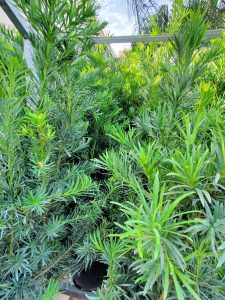
So, you are interested in a hedge, but also a tree that is fairly wind-resistant? Perhaps you would like a Podocarpus which can be used either as a hedge, a screen or even as a tree. Read further for more information on this very popular woody plant.
Perhaps one of the most common plants at almost any local garden center is the Podocarpus. Regularly used a hedging material, this long-leaved evergreen can be pruned to the height you require with most people keeping their hedges between four to five feet tall. Taller plants can also be maintained and used as a formal screen. Plan before you put in hedges. Keep in mind not to plant shrubs too close to the house which can cause moisture and maintenance access issues. Spacing between individual plants may vary depending on the initial size of the plant, how quickly you want the plants to merge together and if the hedge will be formally or informally maintained. On medium sized specimens, spacing plants two to four feet apart for a formal hedge should be fine. For formal hedges, make sure to prune the top narrow and the base wide (trapezoid-shaped) so that the hedge receives as much sun as possible for good growth. When using Podocarpus for a screen, space them four or more feet apart. Screens can provide an informal application where pruning is reduced and the Podocarpus is encouraged to retain its individual characteristics and look less groomed and more natural.
Worldwide, there are over one-hundred species of Podocarpus. Locally, there are several Podocarpus species and cultivars to choose from offering different looks and uses. For instance, Podocarpus macrophyllus ‘Pringles’ is a naturally dwarf type which grows from three to five feet tall at maturity. This dwarf characteristic reduces the need for pruning and is a natural for a short hedge. Other choices include Podocarpus macrophyllus var. angustifolius which is a narrow, columnar tree with curved leaves. Another selection, Podocarpus macrophyllus var. maki has erect branches, but is also columnar in form. Weeping Podocarpus, Podocarpus gracilior, provides another look with drooping branches that give a soft texture unique in the landscape. While all of these Podocarpus can be used as hedges or screens, the taller Podocarpus mentioned can reach thirty-five to forty feet tall with a twenty-foot spread making them useful as small trees that are known to be very wind-resistant.
Always plan before you plant including calling 811 before you dig. Podocarpus do best in full sun, but will tolerate some partial shade, and are not fussy about the soil as long as it is well-drained. Poor drainage will set this plant up for stress and potential root rots. Known to be very drought tolerant once established, most Podocarpus are salt-tolerant as well.
Besides root rot issues in wet soil, Podocarpus is generally pest-free other than the occasional Podocarpus aphid which attacks new growth causing leaf curling and distortions. Bluish-purple in color, Podocarpus aphid infestations can be easily controlled with insecticidal soap used as per label directions for spot treatments.
Podocarpus are both Florida-Friendly Landscaping™ approved, and not on the invasive list. While perhaps overused in our landscapes, and somewhat slow-growing, Podocarpus are multipurpose making great hedges, living screens, and hurricane-tolerant trees that are beautiful and sustainable in any landscape! For more information on all types of trees and shrubs suitable for our section of Florida, you can also call the Master Gardener Volunteer Helpdesk on Mondays, Wednesdays and Fridays from 1 to 4 pm at 764-4340 for gardening help and insight into their role as an Extension volunteer. Ralph E. Mitchell is the Director/Horticulture Agent for UF/IFAS Extension – Charlotte County. He can be reached at 941-764-4344 or ralph.mitchell@charlottecountyfl.gov. Connect with us on social media. Like us on Facebook @CharlotteCountyExtension and follow us on Instagram @ifascharco.
Resources:
Gilman, E. F. & Watson, D. G. (1994) Podocarpus gracilior – Weeping Podocarpus. The University of Florida Extension Service, IFAS.
The Florida-Friendly Landscaping™ Guide to Plant Selection & Landscape Design (2010) The University of Florida Extension Services, IFAS.
Landre, C. (2022) Weeping Podocarpus Tree – Podocarpus gracilior. South-Florida-Plant-Guide.com.
American Conifer Society (2021) Podocarpus species. https://conifersociety.org/conifers/podocarpus/
Gilman, E. F., Watson, D. G., Klein, R. W., Koeser, A. K., Hilbert, D. R., & McLean, D. C. (2018) Podocarpus macrophyllus: Podocarpus. The University of Florida Extension Service, IFAS
Jauron (2002) Selecting and Planting Hedges. Iowa State University.
Gilman, E. F. & Watson, D. G. (2014) Podocarpus macrophyllus var. angustifolius. The University of Florida Extension Service, IFAS.
Missouri Botanical Garden (2022) – Podocarpus macrophyllus. https://www.missouribotanicalgarden.org/PlantFinder/PlantFinderDetails.aspx?taxonid=285416
Landre, C. (2022). Podocarpus macrophyllus. South-Florida-Plant-Guide.com.
Landre, C. (2022) Podocarpus macrophyllus ‘Pringles’ – Dwarf Podocarpus. South-Florida-Plant-Guide.com.
A New Podocarpus? No, Just Aphids! The University of Florida Extension Service, IFAS – Orange County.
Reynolds, C. (2021) Podocarpus ‘Pringles’ more versatile than the species. The Ledger
The UF/IFAS Assessment of Non-native Plants in Florida’s Natural Areas. (2022) The University of Florida Extension Service, IFAS.
Source: UF/IFAS Pest Alert
Note: All images and contents are the property of UF/IFAS.



